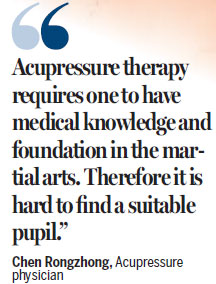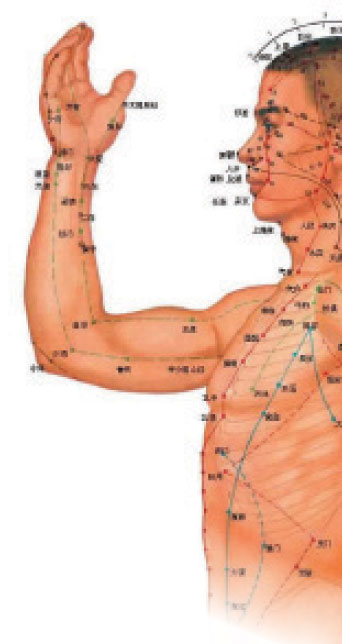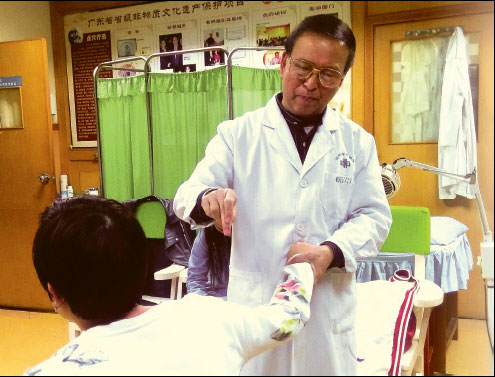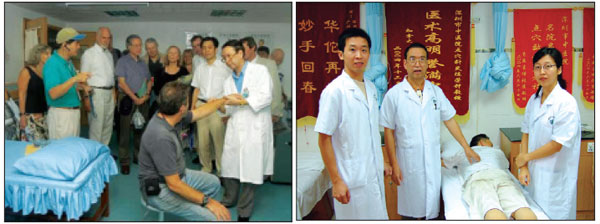Healing under pressure
Updated: 2015-02-05 09:25
By Zhou Mo(HK Edition)
|
|||||||||
While Chen Rongzhong has many patients from HK queuing up at his acupressure clinic in Shenzhen, he's also a bit worried that soon there may not be too many physicians to carry on the legacy. A report by Zhou Mo.
Zhang Songmei rises from her wheelchair and makes her way around the patients' area of Shenzhen Traditional Chinese Medicine (TCM) Hospital. She moves uncertainly, like a toddler, while her husband and daughter are unable to hold back tears of joy. The 80-year-old was felled by a stroke a year ago. She was confined to a wheelchair, unable to walk.
"I could not even move my limbs," Zhang recalled. "It was really painful."
Her case appeared nearly hopeless. Zhang's family fell into despair. Zhang's husband said every visit to a new doctor which yielded the same unpromising prognosis, landed like a blow to him. "We visited a number of doctors and spent a large amount of money, but all ended with no result."
Finally Zhang came to Chen Rongzhong, a 67-year-old physician at the Shenzhen TCM hospital.
Chen is a specialist in acupressure therapy, a branch of traditional Chinese medicine he has studied for three decades.
The walls of Chen's office are covered with photos of him treating patients. Some of the photos are accompanied by news stories about his work. On the desk lies a well-worn brochure. He flips eagerly through the pages, pointing out different photos detailing his research into the field.
"You see? The former under secretary-general of the United Nations Maurice Strong and former deputy prime minister of Thailand Chavalit Yongchaiyudh were my patients," Chen says, smiling at the photos.
Inspired by martial arts

Chen sees his role not merely as a practitioner but also defender of a healing art that's dying.
Acupressure therapy was a late addition to the practice of traditional Chinese medicine. It was a legacy that came from masters of martial arts who discovered that even the slightest pressure on vulnerable points of the body could disable an opponent quickly.
The natural pressure points of the human body are highly sensitive, even vulnerable, whether they are gently stimulated or struck forcefully. During the Ming Dynasty (1368-1644), martial artist Zhang Sanfeng developed a series of boxing movements based on the principles of acupressure.
Those movements later evolved into a form of medical treatment. Physicians would press their fingers on specific pressure points on patients, in order to promote smooth blood circulation, restoring impaired body functions and healing illnesses.
In stories about Chinese kungfu, acupressure is sometimes described as a magical tool. Although the traditional therapy is highly effective for treating neuropathic disease, such as stroke, facial paralysis and childhood cerebral palsy, its usefulness in other health conditions is limited. "Fiction has 'deified' the method," Chen said.
Despite hundreds of years of historical development and exposure in popular fiction, the traditional healing art is in danger of dying out.
"Few young people are willing to study the technique," Chen complained. "That makes me worry."
In 2014, "Jia's Acupressure Therapy", which Chen named after his tutor Jia Lihui, was listed on China's intangible cultural heritage list.
To preserve the traditional technique, Chen spares no effort, conducting research and study, giving frequent lectures and taking on apprentices. He also has helped to promote the treatment method in Japan, Canada and other places, believing that the more people learn about it, the more likely it is to stay alive.
He has been invited to give talks to medical students at the Chinese University of Hong Kong, and teach Hong Kong residents who are interested in the technique. More and more people from the city travel across the border to seek acupressure treatment.
Among them is Zhang Qinglian, a Hong Kong resident living in Kwun Tong. Suffering agonizing pain from cervical spondylosis, Zhang came to Chen last year and has seen signs of improvement after five sessions with the physician.
Despite these successes, there doesn't seem to be much hope for this school of therapy. Chen has only one apprentice, training under him since 2012. It does not look like he will find another one soon after his lone tutee graduates this year.
Not many takers
"Acupressure therapy requires one to have medical knowledge and foundation in the martial arts. Therefore, it is hard to find a suitable pupil," Chen explained.
Chen is teaching the techniques to his twin son and daughter though.
"My father used to play recordings of the therapy in progress again and again at home and let my sister and I practice," his son, Chen Yaolong, said. They are shaping up as skilled practitioners of the technique.
Chen senior's first exposure to acupressure therapy happened at an international medical conference in 1985. He watched the functions of a patient's legs being restored within minutes and was amazed by its effectiveness.
He travelled a thousand miles to Shandong province to study under Jia Lihui, a master in the field. He did not confine himself to Jia's tutelage though, seeking instruction from anyone who could add to his knowledge. Many experts had turned him down at the outset, but came round after realizing how keen Chen was to learn.
Chen says he owes his achievements to "having great opportunities to learn from outstanding tutors". He is committed to passing down what he picked up from them.
In his patients' room, Chen watches Zhang move step by step, wearing a slight smile. That is the reward of his lifetime of dedication.
Contact the writer at sally@chinadailyhk.com

|
Chen Rongzhong's acupressure remedies have brought hope to many who did not think they would walk again. Edmond Tang, Parker Zheng / China Daily |
|
Chen with his twin children in his clinic. The number of young people joining the profession is few and far between. |
(HK Edition 02/05/2015 page7)

